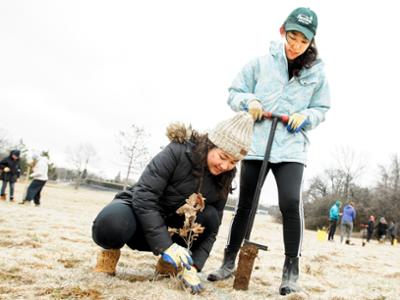Reforestation and Existing Forests

What is Reforestation?
 Reforestation on campus accelerates the ecological development of agricultural land and helps to preserve native species and biodiversity. The Land and Stewardship Plan seeks to implement the five following guiding principles:
Reforestation on campus accelerates the ecological development of agricultural land and helps to preserve native species and biodiversity. The Land and Stewardship Plan seeks to implement the five following guiding principles:
-
Promote academic teaching/research opportunities
-
Maximize carbon storage and sequestration from our forests and open/agricultural lands
-
Protect and expand the health and diversity of native flora and fauna through reforestation, invasive species management, and appropriate silvicultural practices.
-
Facilitate low-impact recreation and wellness opportunities
-
Promote biodiversity and native wildlife populations
All future work in our open and forested lands will be made with careful consideration of research, biodiversity, and sustainability goals.
Identification of Open Lands and Forests
Hamilton’s open and agricultural lands generally include those that are currently or were formerly under agricultural lease contracts with neighboring farms and certain areas vacated by the former nine-hole golf course.
Hamilton Open/Agricultural Lands


Forest Lands


Land/Forest Projects and Priorities
Below, we identify specific land/ forest management strategies, examples of ongoing projects, the research/educational and sustainability (carbon) impact of each strategy.
Golf Course Reforestation


Tract 11 Reforestation Area


Short-Term (5-Year) Goals for Land & Forest Management
| Areas | Goal | Management Strategies | Completion Timeline |
|---|---|---|---|
| Tract 11 | Reforestation | Native trees planted in fenced enclosures and deer exclusion tubes. Success of different strategies monitored/compared. | 2021-23 |
| Tracts 5 & 6 | Reforestation | Native trees will be planted in deer exclusion tubes by an external company. | 2022-25 |
| Tracts 9 & 10 | Managed Grassland and Shrublands | Brush-hogging on a rotating schedule in the late fall (after nesting season) every three years to reduce shrub encroachment and maintain early-successional stage. | 2022 |
| Golf Course | Reforestation | Native trees will be planted in deer exclusion tubes by students in classes and outreach events. | 2019- |
Get Involved in Sustainability at Hamilton
Research
Several students are involved in reforestation projects and research alongside Hamilton faculty and staff. Numerous Hamilton courses take advantage of forests and open land to support hands-on learning in activities that are integral parts of the curriculum. Ongoing projects include:
- Monitoring of tree species diversity
- Surveying wildlife communities (small mammal live-trapping)
- Quantifying herbivory and seed predation
- Measuring soil carbon in different land use
- Monitoring of carbon sequestration
- Measuring carbon, nitrogen, and methane cycling
- Monitoring of water cycle and soil moisture
Contact
Contact Name
Brian Hansen
Director of Environmental Protection, Safety and Sustainability
